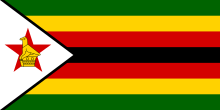Education in Zimbabwe
 |
|
| Ministry of Primary and Secondary Education Ministry of Tertiary and Higher Education |
Jonathan Moyo |
|---|---|
| Budget | $750 million (public, all levels) |
| Primary languages | Shona, Ndebele English |
| System type | State, private |
| Established Initiated |
17 October 1979 4 May 1980 |
| Total | 83.6% |
| Male | 87.8% |
| Female | 80.1% |
| Total | 3,120,000 |
| Primary | 93.9% |
| Secondary | 47.2% |
| Post secondary | 5.8% |
Education in Zimbabwe is under the jurisdiction of the Ministry of Primary and Secondary Education for primary and secondary education and the Ministry of Higher and Tertiary Education, Science and Technology Development for higher education. Both are regulated by the Cabinet of Zimbabwe. The education system in Zimbabwe encompasses 13 years of primary and secondary school and runs from January to December. The school year is a total of 40 weeks with three terms and a month break in-between each term.
In 1980, education was declared a basic human right by Robert Mugabe, the leader of the ZANU party, which changed the constitution to recognize primary and secondary public education as free and compulsory. One of Zimbabwe's Millennium Development Goals was to achieve universal education for all students; however, the goal was not achieved as of 2015 due to a public health crisis, economic downturn and inability to afford costs associated with education. The country is currently workings toward the Sustainable Development Goal of providing universal and free education to all students by 2030.
Due to large investments in education since independence Zimbabwe has the highest adult literacy rate in Africa which in 2010 was 92 %.
The British South Africa Company arrived in the 1890s to Rhodesia, the area now known as Zimbabwe, Malawi and Zambia. The Company administration of Rhodesia created Christian missionary schools to serve local communities. Missionary schools provided an education for the indigenous population that focused on agricultural production and industrial development including carpentry and building. N.J. Atkinson claims that in order to control the local population, the Company limited education and censored knowledge in schools. Furthermore, he argues that the eurocentric education system was a structural institution that reinforced the superiority of white settlers even though they were the minority of the population. Missionary schools perpetuated social and economic repression of the indigenous population by reducing their chances of earning well-paying jobs or positions of power. Rugare Mapako claims education to Africans offered limited academic and foundational skills in order to promote labor exploitation and indentured servitude. Limited access to a quality education kept Africans subordinate to white colonists in order to advance British political and economic gains.
...
Wikipedia
